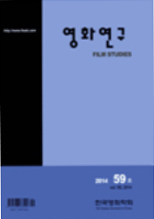- 영문명
- Study on Internality of Film Acting: Focusing on Acting Analysis of 'The Bridges of Madison County'
- 발행기관
- 한국영화학회
- 저자명
- 오윤홍
- 간행물 정보
- 『영화연구』제55호, 331~360쪽, 전체 30쪽
- 주제분류
- 예술체육 > 예술일반
- 파일형태
- 발행일자
- 2013.03.31
6,400원
구매일시로부터 72시간 이내에 다운로드 가능합니다.
이 학술논문 정보는 (주)교보문고와 각 발행기관 사이에 저작물 이용 계약이 체결된 것으로, 교보문고를 통해 제공되고 있습니다.

국문 초록
영문 초록
Camera acting largely brought about the formal changes in acting art through the technical mechanism of camera, wholly different from staging acting. Cameras are the representative medium for expression of acting art in these days, and are popularly spreading, making some forms that are distinguished from stages. While the needs and demands for camera acting are increased in the commercial aspect, the specific training method of how actors/actresses can perform the camera acting, and it may be a serious problem that the acting education is practiced in dramatic performance methodology. For the acting of actors/actresses the ‘space’ in which acting performances are conducted is very important. The space of stage and frame is surely an another dimension, in particular, the close-up and bust shots promote the psychological intimacy with audiences, which is distinctively different from the acting method in which a stage is away from seats in a theater. In addition, since the close-up shot emphasizes the internality of a character, the acting of actors/actresses in close-up shot may be the method of ‘being’ as the character rather than an acting. As Mary Ellen O’ Brien said, ‘an excellent actor/actress acts, as if he/she is in real life and seems to experience the output every moments,’which is an old issue of film acting. There is no evidence that the completion of acting can be enhanced, even though actors/actresses experience the ‘internality’ of their roles through acting. However, actor/actress’‘experiences’ in front of the lens rather than on the stage reinforce the presence of characters, which camera leads audiences to percept. Therefore, the methodology of camera acting should start from the understanding and recognition of the camera media. The camera acting requires the understanding of features of (capturing) viewing method of camera itself, frame, shot, and continuity (continuous combination of shots) and the recognition of how great expression an actor/actress’ silent ‘face’ has in a close-up shot, as stage acting needs the understanding of mechanism of seats. This study intends to focus on the ‘internality of film acting’. The internality of a character has been evolved into a new expression which can put the human’s soul into a screen by finding a close-up. From the film, various devices were developed to visually transfer the internality of a character and freely enumerate many images. In other words, the principal methodology of film acting is to reveal the ‘internality’ of a character, which may be an significant difference from the dramatic performance. First, the internality of a character is revealed in tight shot or close-up. This shot is to erupt a very strong energy of a character, in spite of focusing on the face of him. It is wholly different from the acting space on a stage. Second, the close-up acting is also considerably related with the emotional sympathy of an actor/actress. The ‘emotion’ is more important than actions. Third, the silence is more important than lines in the shot. Fourth, the ‘assimilation’ between an actor/actress and a character is very essential. And fifth, this shot dose not allow any disguised acting: the acting consciousness of an actor/actress is not permitted. In this respect, the most important thing in the film acting is to consider the method to receive an object by camera. In the acting level,the acting of ‘being’ through the internal experiences of actors/actresses,360영 화 연 구 ․ 5 5 호characters’ ‘aliveness’ at ‘that moment’ may be more significant than a simply ‘disguised’ acting. In the ‘moment’, an actor/actress can experience a point of time to be ‘being’ as his/her character and the degree of experience is very high, which is consistent with ‘acting theory of experience’ mentioned by Constantin Stanislavsky (1863∼1938). Along with method acting, his acting theory signi
목차
1. 서론
2. 영화연기의 내면성에 관한 이론적 배경
3. 영화 <메디슨 카운티의 다리>에서 본 영화연기 방법론
4. 결론
키워드
해당간행물 수록 논문
- 1920년대 초반 조선의 영화산업과 조선영화의 탄생
- <사랑방 손님과 어머니>의 각색과 3막구조 연구
- Early Silent Western Films: the establishment of the genre convention
- 통합예술교육과 STEAM(융합인재교육) 기반의 영화교육 교육과정 개발 필요성 연구
- 영화연기 고유성 측면에서 바라본할리우드 메소드 연기의 반작용
- <피에타>를 통해 본 몸의 사회학적 연구
- 한국영화에서 한국전쟁이 재현되는 변화과정에 관한 연구
- <도가니>(황동혁, 2011)와 <부러진 화살>(정지영, 2012)
- 영화와 기술 그리고 ‘사회적인 것’의 구성
- 한국 예술영화 담론의 흐름에 관한 연구
- 2000년대 한국 스릴러 영화의 모성 재현 연구
- 국제공동제작영화의 지원 정책과 현황 연구
- 변신모티브영화의 시각성
- 시뮬라시옹을 통해 본 <사랑을 카피하다>
- 자기조력적 영화치료와 상호작용적 영화치료의 효과 비교
- 영화연기의 내면성(內面性)에 관한 연구
- 관객으로서의 탈북자: 탈북의 자기표상과 영화 수용
- 영화연구 제55호 목차
- 독일 위생영화를 통해 본 조선 콜레라위생영화(1920)와 천연두위생영화(1922)의 특징과 한계
- 멜로 영화의 내적 리듬과 이미지에 관한 연구
- 이준익 영화의 카니발리즘 연구
- 윤봉춘 일기 연구
- 영화 <마더>에 나타난 수행적 모성 정체성에 관한 연구
- 2012년, 상호텍스트성의 어떤 경향
- 고레에다 히로카즈론
참고문헌
관련논문
예술체육 > 예술일반분야 BEST
- 생성형 AI 도구와 디자이너의 협업 프로세스 개발 - 이미지를 통한 아이디어 확산에서 고해상도 렌더링까지
- ‘일과 삶의 균형(Work-Life Balance)’ 척도 개발을 위한 연구
- 디자인 전공 교과목에서의 생성형 AI 도구 활용 사례 연구
예술체육 > 예술일반분야 NEW
- 한국영화의 촬영과 조명 시리즈 2: 영화 '형사, Duelist'의 Visual Concept 및 조명플랜
- 포스트모더니즘적 영상표현에 관한 연구 -실사 영화와 애니메이션 영화의 상호작용을 중심으로-
- 소니 HVR-Z1N 카메라의 중요한 메뉴에 관한 소고
최근 이용한 논문
교보eBook 첫 방문을 환영 합니다!

신규가입 혜택 지급이 완료 되었습니다.
바로 사용 가능한 교보e캐시 1,000원 (유효기간 7일)
지금 바로 교보eBook의 다양한 콘텐츠를 이용해 보세요!



